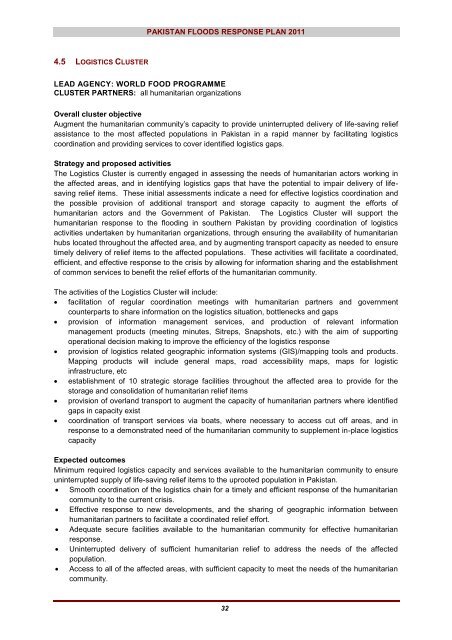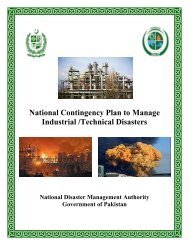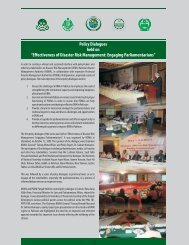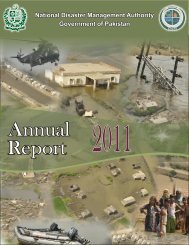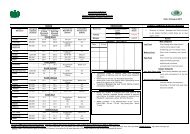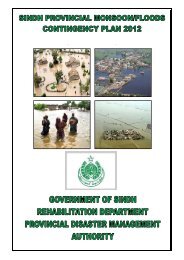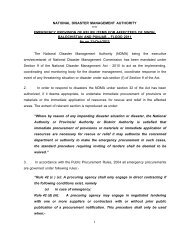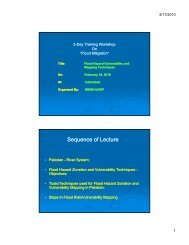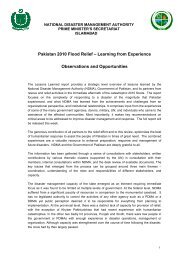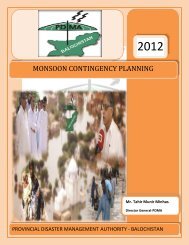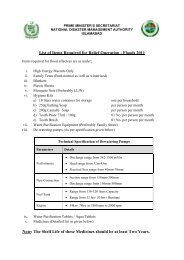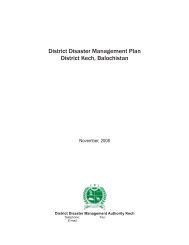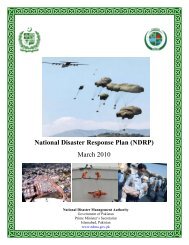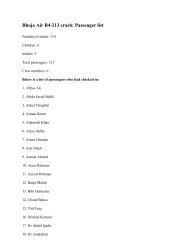Pakistan Floods 2011 - Humanitarian Response
Pakistan Floods 2011 - Humanitarian Response
Pakistan Floods 2011 - Humanitarian Response
- No tags were found...
You also want an ePaper? Increase the reach of your titles
YUMPU automatically turns print PDFs into web optimized ePapers that Google loves.
PAKISTAN FLOODS RESPONSE PLAN <strong>2011</strong>61B4.5 LOGISTICS CLUSTERLEAD AGENCY: WORLD FOOD PROGRAMMECLUSTER PARTNERS: all humanitarian organizationsOverall cluster objectiveAugment the humanitarian community‟s capacity to provide uninterrupted delivery of life-saving reliefassistance to the most affected populations in <strong>Pakistan</strong> in a rapid manner by facilitating logisticscoordination and providing services to cover identified logistics gaps.Strategy and proposed activitiesThe Logistics Cluster is currently engaged in assessing the needs of humanitarian actors working inthe affected areas, and in identifying logistics gaps that have the potential to impair delivery of lifesavingrelief items. These initial assessments indicate a need for effective logistics coordination andthe possible provision of additional transport and storage capacity to augment the efforts ofhumanitarian actors and the Government of <strong>Pakistan</strong>. The Logistics Cluster will support thehumanitarian response to the flooding in southern <strong>Pakistan</strong> by providing coordination of logisticsactivities undertaken by humanitarian organizations, through ensuring the availability of humanitarianhubs located throughout the affected area, and by augmenting transport capacity as needed to ensuretimely delivery of relief items to the affected populations. These activities will facilitate a coordinated,efficient, and effective response to the crisis by allowing for information sharing and the establishmentof common services to benefit the relief efforts of the humanitarian community.The activities of the Logistics Cluster will include: facilitation of regular coordination meetings with humanitarian partners and governmentcounterparts to share information on the logistics situation, bottlenecks and gaps provision of information management services, and production of relevant informationmanagement products (meeting minutes, Sitreps, Snapshots, etc.) with the aim of supportingoperational decision making to improve the efficiency of the logistics response provision of logistics related geographic information systems (GIS)/mapping tools and products.Mapping products will include general maps, road accessibility maps, maps for logisticinfrastructure, etc establishment of 10 strategic storage facilities throughout the affected area to provide for thestorage and consolidation of humanitarian relief items provision of overland transport to augment the capacity of humanitarian partners where identifiedgaps in capacity exist coordination of transport services via boats, where necessary to access cut off areas, and inresponse to a demonstrated need of the humanitarian community to supplement in-place logisticscapacityExpected outcomesMinimum required logistics capacity and services available to the humanitarian community to ensureuninterrupted supply of life-saving relief items to the uprooted population in <strong>Pakistan</strong>. Smooth coordination of the logistics chain for a timely and efficient response of the humanitariancommunity to the current crisis. Effective response to new developments, and the sharing of geographic information betweenhumanitarian partners to facilitate a coordinated relief effort. Adequate secure facilities available to the humanitarian community for effective humanitarianresponse. Uninterrupted delivery of sufficient humanitarian relief to address the needs of the affectedpopulation. Access to all of the affected areas, with sufficient capacity to meet the needs of the humanitariancommunity.32


